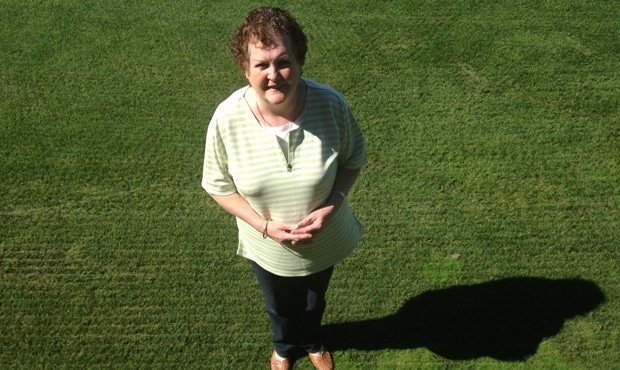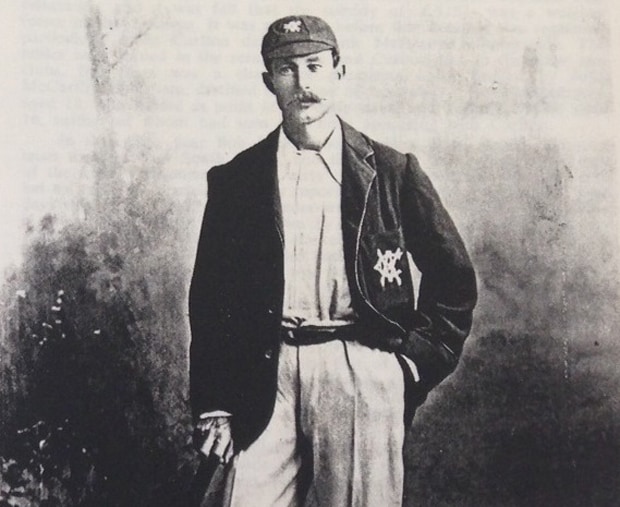The names Heatley and Gardiner rightly remain the constants at Princes Park, in fitting tribute to the legacy left by the pioneers of the old ground.
And yet the name Warne is just as significant in the pantheon of Carlton history. For it was the noted cricketer Tom Warne and his son Bert who as Princes Park’s resident curators collectively contributed to the upkeep of the hallowed turf for the first 70 years of its existence.
A curator at Carlton’s old ground The Triangle from 1892, Tom assumed duties at Princes Park during the reign of Queen Victoria in 1897. His understudy Bert followed suit from 1943 (the year before Tom’s death) and remained curator until his retirement in ’68.
Thankfully, Di Perkins is still around to keep the Warne family flame aflicker - and, on the 70th anniversary of Tom’s passing (he died at the ground), she recently returned to Princes Park to draw attention to a bygone era at Carlton.
“Tom was a small man of stature but big of heart,” Di said. “His eldest son Tom contracted meningitis as a baby, which left him mentally disabled, and when old Tom used to bat for his team on looking up he’d see his son on the grandstand roof. But the boy never came to any harm in these adventures.”
“The family milked cows that lived in paddocks around the ground and the Triangle, and sold milk in the district. Tom’s wife Alice also reared turkeys and sold them, and I might add that my father raffled one for himself for a bit of money on the side.
“My Dad Cliff and his brother Vern (a curator at the Melbourne Ground and later the Albert Ground) liked footy days as they would pour treacle into the turnstiles so that money would stick. They’d then clean the turnstiles and gather the added pocket money. They’d also collect pickpocketed empty wallets from toilet cisterns which they’d return to the rightful owners for a reward.”
Tom and Alice took up lodgings in the old caretaker’s cottage, before relocating to a brick house which flanked the north-eastern pocket of the ground. They shared that premises with a maiden aunt and their 12 children – six sons Tom, Kenneth, Vernon, Bert, Frank and Clifford, and six daughters Goretta, Alice, Ida, Sheila, Clare and Dorothy – and there he died in 1944.
Di, the granddaughter of Tom and niece of Bert, came armed with a wonderful collection of anecdotes, newspaper clippings and precious film footage which only serve to enhance the Warne legacy.

Tom Warne's granddaughter Di Perkins. (Photo: Supplied)
She also graciously contributed her own written personal recollections of happy times – anecdotes handed down to her from her parents “who had great love, respect and admiration for Tom Warne and his wife Alice”.
By way of introduction, Thomas Summerhayes Warne was born in County Clare in Ireland around 1872. He was one of six children who later relocated with his family to Australia. It was in Melbourne that Tom met his future wife Alice Donnelly, herself an Irish native.
A noted local cricketer in the days of Jack Worrall, Harry Graham and Jack Saunders, Warne belted nearly 10,000 runs for Carlton. Such was his prowess that he also made 1933 runs in 40 first class matches for Victoria at 31.18 and bowling leg breaks took 39 wickets at 39.44.

Tom Warne during his cricketing days. (Photo: Supplied)
Such was his standing that at summer’s end 1906, Tom accepted an invitation to sail to Philadelphia and fulfil duties as curator and coach of the Belmont Cricket Club.
Four years later, he was recognised with the awarding of a benefit match at the MCG – the only non-Test representative to be accorded such a distinction in Australia.
An exceptional article penned by The Sporting Globe’s Hec de Lacy in March 1942 provides fascinating insight into the Carlton of yesteryear, the emergence of Princes Park from a paddock and the life of one of the true pioneers of Princes Park through ol’ Tommy’s memoirs.
Here, de Lacy records the curator’s love for the Carlton ground – “a beautiful sward of verdant green, with an amphitheatre of commodious stands”.
The following, Part 1 of a tribute to Tom Warne, is an edited extract of de Lacy’s feature article.
“ . . . The Carlton ground of today, cricket lover and football fan, was the Melbourne City Council tip of 1896. Before that it was a swimming pool known as the Cow Paddock.
The hand of Tommy Warne has coaxed from the mullock of the tip that beautiful playing surface of today. He, and nobody else. Warne was the ground’s first curator.
Today, at 73, with his assistant in the army, he still waters and rolls the wickets and shaves the green sward.
So let’s talk of Tommy Warne and the Carlton ground – both personalities in the kingdom of sport.
Warne and Carlton are indivisible. He was one of this State’s greatest cricketers. In his heyday of giants, he stood out as Carlton’s champion and captain. He it was who “christened” the oval he has tended so lovingly with a century in the first match played there against Hawksburn. In the first season the Carlton club played on the oval Warne batted nine times. Once he was not out. He scored 1011 runs at an average of 126.37. His top score was 402, against Richmond.
Carlton men of his day loved the quietly spoken Tommy Warne, and when his cricket days were over, they united with other lovers of a real sport to give him a testimonial. There is more to Tommy than that, but for the moment turn to his charge –the Carlton ground.
Back in the reign of Queen Victoria, the Blues played games just as dramatically and keenly as they do today. Those days Carlton were at home when occupying the old triangular ground outside Ormond College, on which the women’s University hostel is now built.
They had a pavilion and a fence. But they wanted something better. Applications for land in Royal Park were refused, but the Blues battled on. Finally they persuaded the powers that be to let them have the area of ground they now occupy. It was then a tip.
Tommy Warne, as curator, confesses that the area was mostly broken glass and rubbish. To make the first wicket he had to scrape away a collection of oyster shells and broken glass. That was in 1897.
Carlton people were really keen. They were over at the ground every morning at 6.0. Sundays were religiously set aside for work at the ground.
At that time the ground measured approximately 200 by 180 yards. The old pavilion was moved in sections from the Triangle. But the job was not done overnight and there might be some who remember that visiting teams in that first year had to dress in a stable nearby.
The rubbishy composition of the soil is emphasised by the fact that when the big brick stand was built – the first grandstand erected on the ground – at the eastern end they had to go down16 feet to get anything approaching a solid foundation. The brick cottage on which Tommy Warne now lives is built on a raft. No solid foundation was available.
A feature of the present ground is the commodious banks surrounding the playing field. About the time that Carlton was taking shape, the sewerage system came to Melbourne. The clay and excavated soils were carted to Carlton and graded into the present banks. Even in that Warne played the biggest part.
In all, 147,000 loads were tipped into the bank. He himself spread 137,000 of the loads. The final 10,000 loads came from the re-grading of Lygon Street.
Those last loads were carted during the summer, when Warne had more than he could do to look after the playing surface. Labor was employed to spread the soil. The area was lessened as a result of the banking to 188 by 168 yards.
Warne recalls how the filling that was meant for the Carlton embankments began to find its way elsewhere. The carters were being paid for the soil. Bob Heatley, the Carlton President, did his best to stop the trafficking, even taking the police sergeant to the carters.
All to little avail. The drift continued. Then he hit on the idea of getting a few “barrels” at the ground. That broke the trafficking. The carters were always there waiting
for their couple of pots. Tommy Warne had the job of distributing the beer. The banks have returned thousands of pounds to the Carlton club.
“We had many exciting sporting events apart from cricket and football(,”said Warne). We promoted the Carlton Wheel Race in an effort to raise funds for the improvement of the ground. Among those who competed was the American Floyd MacFarland, the American crack cyclist. The track was a trifle rough, and two of the competitors brought MacFarland down. I can see him sitting on a table in the dressing room stitching his knee and cursing the world. He wanted to find every man in the race.”
Open air concerts were popular at one time. The Carlton officials tried to promote concerts, but they were not a success. Warne recalls that Rufus Ferguson, afterwards a member of a Melba opera company, was a regular artist.
No story of the ground would be complete without the history of Tommy Warne’s old grey horse. When he was curator at the Triangle a man brought limping horse up to the gate and called Warne.
He said he had walked the horse from Lilydale and was making for the Zoo. The horse could go no farther. Would Warne relieve him of the horse? It was very thin and very lame – in fact, all in. Tom took the horse and the fellow seemed glad to part with it.
Warne tended the sick horse and in a month he was transformed – as fit as a fiddle.
The old grey horse continued to work with the man who had saved its life for more than 20 years.
“He was the best horse in a mower I ever saw,” Tom said proudly. “He could do the job on his own.”
One day, when Warne was away playing with a Victorian elven, the old grey horse burst a blood vessel in the head. Nothing could be done for him, so a weary, sad march was begun across the park to the Zoo – his destination of 20 years previously. The old fellow never got there. He died on the road.
With the start of the 1942-43 season, Warne will have entered his 50th year as Carlton’s curator both at the Triangle and Princes Park.
In part 2 of this tribute to Tom Warne, rare film of the old groundsman and his beloved Princes Park surfaces.


